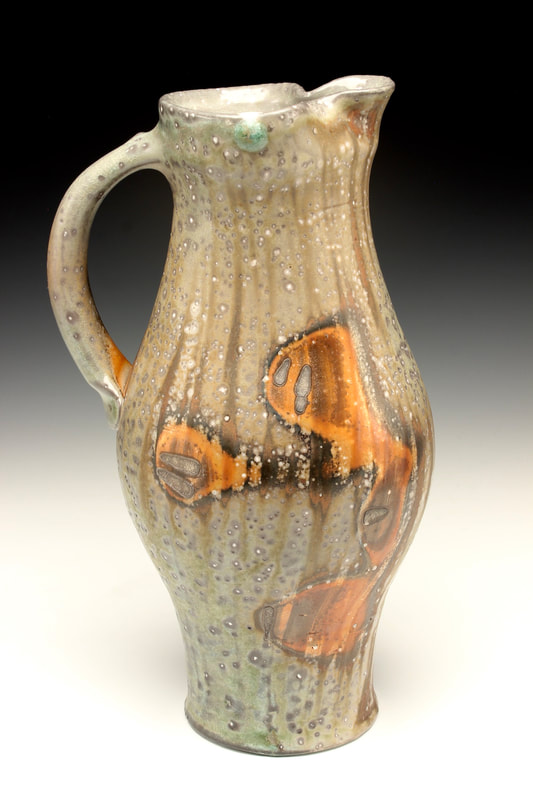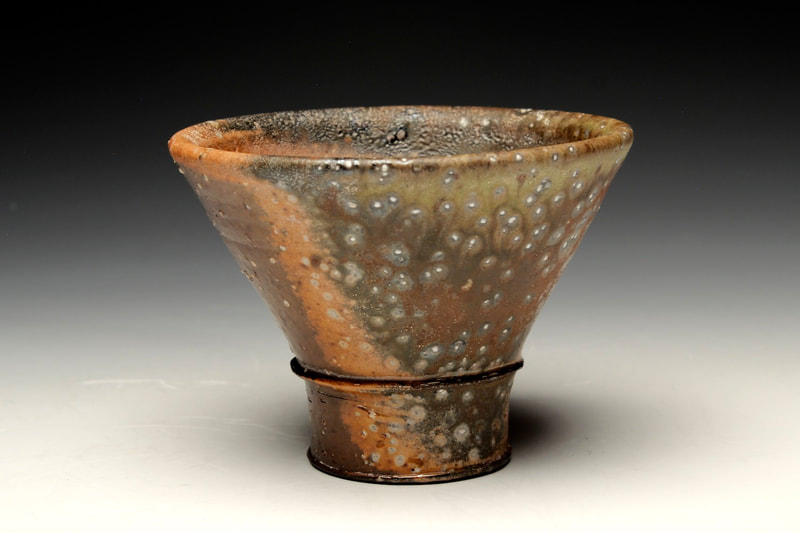|
About Harry: "My name is Harrison Levenstein, I am 28 years old and have been working with clay for about 10 years. I grew up in the mountains of Southern California and went on to pursue ceramics at Humboldt State University. Since graduation I’ve cultivated an itinerant approach to my education. I’ve traveled to work closely with established artists, and taken artist-in-residence positions in studios as far as south-eastern India. Admittedly, I tend to allow the studio to consume the bulk of my free time, but when I’m not making, I lately have been appreciating my new home base in the Berkshires by hiking, bouldering, and mushroom foraging. The pandemic makes things a little trickier, but gathering with friends to enjoy eachothers’ company, cook, and enjoy delicious meals is another favorite pastime. " How did you get into soda firing? "I had been a peripheral participant in a few soda firings over the years, but never fully engaged with the nuance of the process. I began a more focused exploration into soda firing in early November of 2019 when I started a residency at the Red Lodge Clay Center in southwestern Montana. My intent was to utilize their smattering of atmospheric kilns to test new clay bodies and compare/contrast the various firing effects across said clay bodies. However, after my grant proposal was denied, I decided to shift my focus directly to the soda kiln." Do you solely soda fire? If no, how do you decide which work to fire in each firing type? "No. The majority of my education and training in ceramics has been focused on wood firing. I had been firing exclusively with wood for the last 5 years, prior to arriving in Red Lodge. My approach to choosing work is from the ground up, so to speak. As artists working with clay as our medium, choice of clay body becomes our very first in a long line of aesthetic decision making. Since my focus for this research was more on the clay and comparing firing processes, I did minimal formal exploration. It was like helping my pots pick a new wardrobe. In terms of juggling firing processes, what works for me is taking really good notes, and having a couple clear ideas/goals in mind about what I’m looking for in terms of effects. It helps to have concrete ideas to keep me focused, but also to remain attentive to the surprises that these processes inevitably provide." What inspires your artwork, and does that relate to part why you soda fire? "Inspiration comes in different forms. My work is rooted in function, so use is a big consideration. Mostly it comes from my environment. Nature already creates the most beautiful things. My job is just to notice, appreciate, and pay homage to it as best I can. Atmospheric firing processes appeal to me because they bring me closer to my materials and process. Wood, and soda firing require an attention and relationship to fire that other methods don’t." What is your unique aesthetic approach to soda firing? "I’m not sure how unique my aesthetic approach is. My plan when starting to soda-fire was simply to approach the process in the same ways I did with firing wood kilns. This would include paying close attention to the way the kiln is stacked, how each pot is placed in relation to one another, utilizing wadding as decoration, and maintaining a similar firing schedule and reduction cooling cycle. I wanted to achieve surfaces that highlighted both the effect of heavy soda accumulation, and the flashing potential of the bare clay bodies. One way I achieve this balance is by using wadding as a primary decorative element. I like to wedge wads between pots to break the flame’s path and use it to create directional marks on the clay’s surface. I’ve also been enjoying using an alternative, high-iron wadding to create very dark, even black marks on the surfaces of my pots that can sometimes leave an incredible concentric ring pattern within the wad mark itself." What clays, flashing slips, or glazes are you working with to create your unique soda fire surfaces? "I have been using a variety of clay bodies that I developed during my residency at RLCC. Mostly stoneware with enough iron to produce bright reds when reduction-cooled, and with varying amounts of medium to very coarse silica sand to break up and add more depth to the surfaces. Most of the pots are lined with glazes made from locally-sourced hardwood ash. Not much in the way of slips were used as I was trying to focus on creating clay bodies that flashed well enough on their own. However, I do like to collect and sieve my throwing slurry and use it as a slip to add texture to some pots." What is a typical soda-firing schedule? The following breakdown is of one of my favorite firings at RLCC.
Harry Shares more information about his time soda firing during his time at red lodge on his blog. Be sure to join his email list as he will be sharing more resources soon on clay and glaze recipes for the soda kiln.
Did you love this interview? Be sure to join my Soda Fire Educational Series to keep learning more about soda firing by clicking here. To read the archive of other soda fire artist interviews and articles click here. |
Hi, I'm Lisa the artist and creator of this content.
Here on my blog I share behind the scenes, events, and activities related to my art. GET INSPIRATION AND SPECIAL DEALS DELIVERED STRAIGHT TO YOUR INBOX!
Categories
All
Archives
February 2024
|















 RSS Feed
RSS Feed